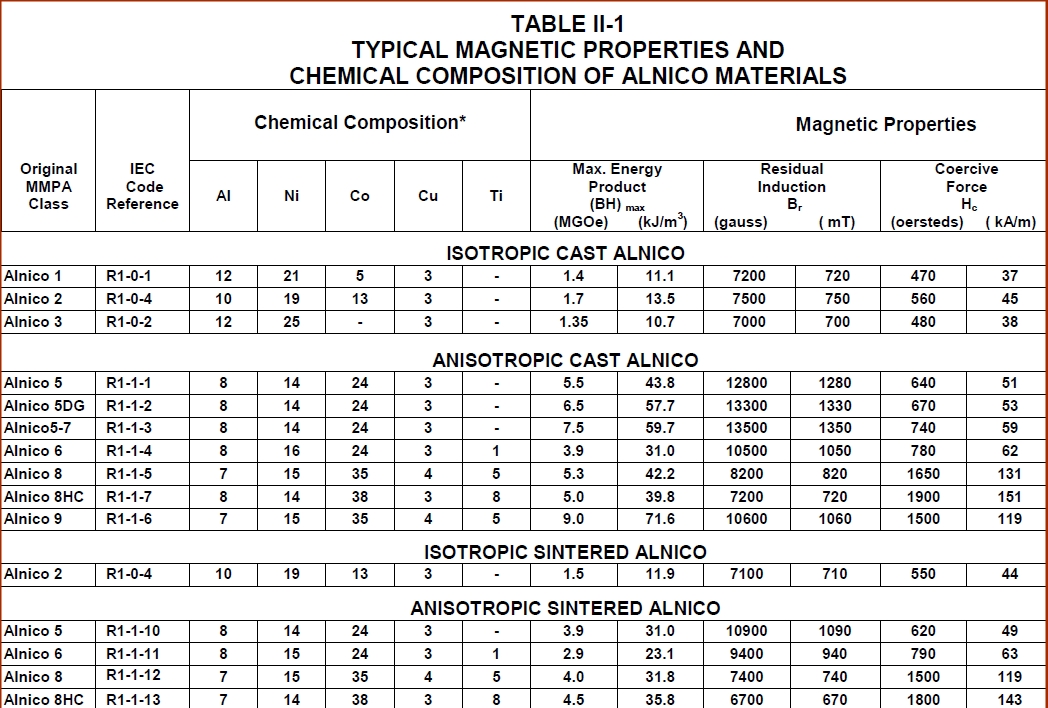Your Cart is Empty
NOW FREE SHIPPING TO 48 CONTIGUOUS UNITED STATES ON ALL ORDERS!!!
Alnico 4 6 8 5DG unoriented alnico 5 and other odd-balls
by vaughn skow January 03, 2023 6 min read
Wow, oh wow ... what began as a simple question about the exact formulation of alnico magnets asked on the WGS forum has turned into quite the blog series! Warning: don't start reading this blog without first reading the ones leading up to this blog!
The Mystical Magical Qualities of Alnico III
Alnico II Properties - The musical Magnet
Qualities of Alnico V magnets - The Magnet that ROCKS!
Okay, ready to read on? Then let's dive in to what I'm going to term the "oddball" AlNiCo (alnico) grades used in guitar pickups and how they sound tone-wise. And here we go!
Sorry gang, but once AGAIN, we are going to need to start with this chart.
Check out a couple things. First, there IS NO alnico 4 listed. Yup, that's how rarely it is used! And secondly, notice that there are actually FOUR different versions of alnico 5 listed.
Hummm ... get any of you to thinking???

So, whatcha thinking?
I bet I can guess! First, you are thinking "hey, but I've heard pickup makers talk about how awesome A4 is ... so what gives?" Right?? And second: Okay, I get the difference between old-style cast Alnico 5 and the shiny new "stintered" versions (If you read my earlier blogs), ... but there are THREE cast versions of A5, so which ones are in guitar pickups? I thought the SAME things ... and holy sheeeet did that first question lead down a week's long deeeep dive research trail.
What I found out about AlNiCo 4 will prove to be so VERY controversial and probably generate so much flack from the pickup makers who tout the God-like qualities of A4 that ... sigh ... I've decided I'm NOT going to publish my findings at this moment, wait till next week, it'll be it's own blog. Here is what I will tell you, by requesting data from the ONLY manufacturer of "alnico 4" in the world I was able to find the metallurgical composition of A4, and the magnetic and physical properties of A4.
This is a big deal !!!
Why is this such a big deal? Okay, young grasshopper, I will instruct by showing you how to answer your own question.
Google search "Alnico Composition Chart" Notice anything that would be considered a big-time head-scratcher? Yeah, you do NOT find A4 on ANY chart, even if you dig for days and use various search engines. I know, I tried. I had to contact manufacturers reps directly ... and found there is only ONE source in the world ... and why! Better yet, search "alnico 4 Composition chart", the results are even MORE telling ... the only place you will find ANYTHING, and ya gotta dig deep, is from everyday folks on forums making guesses, voicing opinions, and so on ... and of course, from the makers touting the greatness of A4! What I found is such a big deal that I have decided it's totally worthy of it's own blog, so that will be NEXT. All I will say now is that everything you may think you know or have been told about A4 is incorrect, or maybe an outright lie of deception.
So, let's move on to the other observations, mostly around Alnico 5.
First IEC R1-1-10, stintered A5 is, as we all know a crappy magnet for guitar pickups or speaker magnets, the stintering process may save some bucks over sand-casting, but they sure don't SOUND the same.
SIDEBAR, IEC is the worldwide commission that insures the same standards exist on all electronic and electrical components all over the world. Most of you are aware of the IEC standard electrical power connector, used on almost every piece of pro gear powered by A/C current. An IEC power connector/cable is the same and fully compatible no matter what country you are in anywhere in the world, if it's IEC ... you know exactly what it is and that it's the same as EVERY other IEC A/C jack on any piece of equipment regardless of the country of origin. This in invaluable when using equipment around the world! It means you can safely plug in your equipment anywhere in the world, at least if you have access to clean A/C mains. See:
International Electrotechnical Commission
But ... what about those three grades of cast A5??
Alnico 5, alnico 5DG and Alnico 5/7? Hummmm .... ??? This one get's a bit technical, so skip this if ya ain't into technical details! Here is the skinny, DG stands for directed grain, and it means they start with column shaped alnico alloys instead of the standard single crystal alloys. This reduces the time and cost of alnico production a little and slightly enhances SOME of the magnetic properties of the magnet. And so, DG alnico is common in high-tech electrical-magnetic devices. However, the old single-crystal version sounds sweeter in a guitar pickup so if your pickup set is made by someone who gets the difference and cares about the outcome, the magnets inside will be standard A5.
From ScienceDirect, the MOST in-depth discussion of Alnico ANYWHERE, EVER:
"In practice, use is made of so-called columnar crystallized alnico alloys instead of expensive single crystals.It is possible to obtain such highly textured alloys by a grain orienting process preceding the thermomagnetic and tempering treatment. The alloys are then cast in heated or exothermic molds onto water-cooled steel or copper slabs. During solidification of the alloy on the cold surface, the grains tend to grow with their long axis parallel to the 〈100〉 directions, perpendicular to the cold surface. This leads to a semicolumnar alloy in which the columnar axes are parallel to one of the〈100〉 directions, for instance, parallel to the [001] direction. It has become common practice to refer to alloys manufactured in this way as alnico DG (directed grain)"
If you can read seriously dry scientific publications, and want to access the world's depository of info on alnico, read it here:
https://www.sciencedirect.com/topics/chemistry/alnico
What about Alnico 6, 8, and 9?
Well, just look at the chard above! You'll notice that these magnets contain a relatively high amount of Cobalt, yet also have energy and induction values far BELOW alnico 5! IE: they are expensive and sound kinda weak and mushy. So, they are rarely used in musical applications like pickups. I've played with them and NEVER found a design where they excel!
"Unoriented" Alnico V, one last rant: Just like alnico 4 ... you may hear some folks bragging about something called "unoriented alnico 5". And folks, when I first started making pickups I was suckered into buying several hundred dollars worth of "unoriented alnico5" bar magnets, and told they would sound more like the vintage Alnico 5 compositions of the 1950's. It was all a lie, or as I prefer to believe, ignorance on the part of the seller. "Unoriented" Alnico V" is basically a scam in my book, it's still anisotropic, which can only be magnetized on one axis, it just does a worse job of holding a magnetic charge because the particles are NOT fully lined-up in the proper north/south axis. This is because the crystals are made to line-up at a cooler temperature than is optimum for the mixture, and so they do not line up as effectively, making the magnet perform worse. True isotropic (unoriented) alnico 5 is NOT produced by ANYONE! A quick peek at EVERY chart by EVERY manufacturer will prove that there is no such thing as an isotropic version of A5 ... the composition simply will NOT solidify in a non-directional ie: "unoriented" direction! One more note, I see this refereed to as "U0A5" and THAT shows up nowhere other than in ... you guessed it, forums and pickup makers sites.
Now, next week ... I'll decide how much I CAN say about Alnico 4 without generating too much hate mail. Oh boy, be sure to read THAT! See ya then!
If I'm never seen or heard from afterwards, you'll know what happened and who the perps were! Just sayin' ...
Leave a comment
Comments will be approved before showing up.
